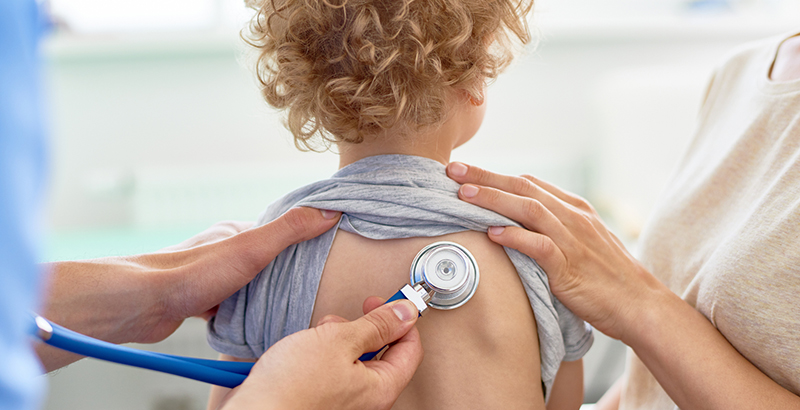Williams: Forced to Run Risks By People We Didn’t Trust, Our Child Got Sick With COVID at School — And Then We had to Send Them Back

Get stories like these delivered straight to your inbox. Sign up for The 74 Newsletter
You’re hurting your kid, people told me. They need to get back to school and be with their friends. They won’t catch COVID there, folks said. And in the unlikely event that they do, they’ll shrug it off and you’ll pop them right back into school.
Naturally, after 18 months of hearing many of these same people demonstrate their commitment to catching and spreading the virus — gallivanting off to holiday family reunions, trips abroad, concerts, etc. — I wasn’t convinced. But, in Washington, D.C., where I live, if you would rather not send your too-young-to-be-vaccinated kids to in-person school this fall, the city hasn’t just blocked your access to a virtual schooling option — it’s started sending child protective services to your house.
So we acquiesced, gritted our teeth, pretended like we felt safe and went to work selling in-person school. We told our two elementary schoolers that we were excited, met up with some of their friends for distanced-outdoor play dates, made a big show of buying school supplies … and then sent them back to campus. “You’re going to have so much fun!” we cheered.
And they did! But only for a moment, because, something doesn’t become true just because we collectively wish it were so. The supposed safety of school reopening amid the Delta variant surge this fall always hinged on the accuracy of a series of assumptions about the probabilities of kids catching the virus, positive cases turning into serious long-term illnesses, and/or hospitals running out of room for new patients.
Early returns from school reopening — a spike in pediatric cases, pediatric ICUs straining to keep pace — suggest that, perhaps, forcing most kids back to school this fall wasn’t the easy slam dunk that advocates promised. Indeed, the situation in our house is a sad reminder that when you’re forced to live with the assumptions baked into someone else’s fantasy world, you can still get stuck with real-world consequences.
On the fourth day of school, a COVID-positive classmate exposed one of our kids to the virus. The school learned about the classmate’s positive test on the sixth day of school, and the class was sent home. Three days later, our kid tested positive and summarily developed symptoms. They worsened for a few days, then plateaued for weeks, coughing and coughing until we got scared enough to go to our doctor, only to learn that there were no appointments available amid the school reopening case surge. The nearby children’s hospital was also overwhelmed, so we searched around until we found an urgent care clinic.
“Lungs sound OK,” the harried doctor told us. “She’s just gonna have to wait this out.”
But, by then, we had already been waiting for what seemed like an eternity. The helpless anxiety of listening to your kid cough themselves awake at night is one of the darkest flavors of parental desperation. It doesn’t improve after weeks of repetition. And it reaches particularly deep now, marinated in the exhaustion of a year and a half of juggling full-time work and child care for a family of five.
Worst of all, it confirmed our skepticism. We had been forced to run risks we didn’t want by people we didn’t trust, and wound up proven bitterly right.
Finally, nearly a month after exposure, our kid started feeling better. The cough eased up. So we (reluctantly) prepared to send them back to school — but it was much harder to sell this time. They were scared.
How do you gaslight a child who’s been sick for most of the first month of school because their community and its leaders put them at risk? How do you tell them that, nah, that wasn’t so bad, the pandemic is totally under control?
Just talk your kid down, folks said — they’re only apprehensive because you are.
It felt like the perfect encapsulation of the kind of selfish motivated reasoning that has made it so hard for the country to successfully confront the pandemic. When humans interpret the world, when we try to make sense of the situations before us, we’re always in danger of misunderstanding them in self-serving ways. This isn’t such a big deal when it’s an individual matter — convince yourself that your daily sodas with breakfast have nothing to do with your pants growing tighter if you must. The consequences of willing comforting beliefs for yourself instead of facing those facts will largely fall on you alone.
But since spring 2020, the pandemic keeps hammering home the same frustrating lesson: when groups of people are unwilling to deal with challenging facts, the rest of us suffer. Take the most obvious all-time example: sure, the climate appears to be shifting, and yes, scientists have been screaming for decades that our own behavior is putting us at risk … but wouldn’t it be more convenient to find a different explanation that doesn’t require us to change our lifestyles at all? Maybe it’s not actually caused by our frequent flying or our meat-heavy diet or our automobiles or our air conditioners. That feels easier to believe, which is almost the same as being better to believe, which, you know, the more you ruminate on it, starts to feel simply true and right.
The key to reasoning this way — interpreting the facts so that they almost always confirm what you’d rather do anyhow — is carefully framing the terms of debate up front. If you think about confronting climate change primarily (or even solely) in terms of how it might impact your ability to fly cheaply to Caribbean beaches every year, then sure, it’s obvious that humans should change nothing about our fossil fuel usage and anyone who thinks otherwise is an ecoterrorist. But if you expand your framing to consider how the worsening storms linked to accelerating climate change could affect the health, safety, and economy of your preferred Caribbean vacation paradises, the chain of reasoning comes out somewhat differently.
The pandemic era has been drenched in this kind of thinking. Folks have been constructing more convenient realities built around self-serving assumptions about what is safe. They’ve isolated potential risks out of their reasoning and focused on other priorities so that they can wind up feeling good and responsible about the choices they’ve made. Don’t like needles? Dig around a little and you can find some comforting conspiracy theory to excuse you from having to get vaccinated. Embarrassed that you missed a week of work with COVID after attending that mask-free wedding two time zones away? Just spend 15–20 minutes on a couple of the right-right wing websites and you can reassure yourself that no, you totally did enough, the masks wouldn’t have helped.
It’s the same reasoning for school reopening. For instance, it is absolutely true that — for their social development, their emotional health, and their academic progress — in-person schooling works better, for almost every kid at almost every time, than virtual learning. But that doesn’t mean that the health dangers involved with reopening in-person schools simply evaporate. And it’s certainly no excuse for undermining efforts to lower those risks by, for example, refusing to get vaccinated or preventing schools from requiring masks on campus or forcing cautious families to send their kids back before they are eligible for the shots.
Sure, school closures are down … but that appears to be driven by schools, districts, and states deciding to set looser family notification and quarantine rules for students. In essence, schools aren’t closing as much as before — not because in-school cases and transmission aren’t happening, but because we’ve changed our levels of precaution. Indeed, the Detroit Free Press noted that by easing its standards, Michigan stands to define one-quarter of its school COVID outbreaks out of existence. That is, they’ll still happen, but we’re just not calling all of them outbreaks anymore. It’s the same with in-school transmission. While it’s common to read and convenient to believe that “in-school transmission is rare,” it’s also hard to be sure of this, since U.S. schools have struggled to keep up with contact tracing throughout the pandemic.
Meanwhile, know that in the two months between schools reopening in the South in August and now (early October), there have been more than 1.8 million new pediatric COVID cases. That, which is assuredly an undercount, given the limited state of U..S COVID testing and reporting, is nearly one-third of the total pediatric COVID cases since March 2020 — in just two months. Convince yourself that that’s just a coincidence, that it’s somehow totally unrelated to nationwide school reopening if you must, but please look yourself in the mirror while you do it.
Know that sending your child means you are accepting an additional risk of facing a month — or more — of living with a nightly jaw clench, as your child just doesn’t seem to be getting better. Know that some children do, in fact, die from contracting COVID-19. Know that the risks for everyone will be dramatically lower for all kids once they’re vaccinated — a possibility that appears to be just weeks away.
And, most of all, know that shrugging and framing these possibilities out of the picture won’t make them actually go away. But hey, maybe you’ll get lucky, and they’ll just happen to someone else. Like my kid.
Get stories like these delivered straight to your inbox. Sign up for The 74 Newsletter


